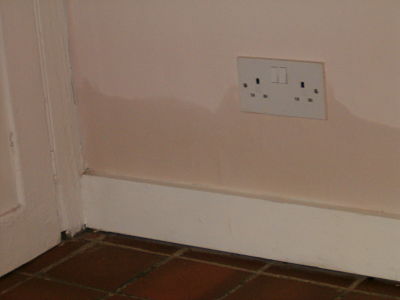Rising damp is the movement from the ground of moisture through walls and floors by capillary action. Depending upon site conditions, it can rise to 1m or more in walls. There is usually a 'tide mark' and sometimes the appearance of white salts.
Rising dampness is minimised by the use of damp proof courses built into the walls. The legal requirement for a damp course was introduced in 1875 and consequently, most older buildings were not built with damp proof courses. Slate, engineering brick or bitumen mixed with mortar were utilised in earlier construction. These earlier damp courses tend to be more unreliable. Bitumen felt damp courses are the most common type and were used mainly between the 1920's and 1980's. Plastic strip damp courses were used from the 1970's and are now the most common type of damp course in new construction.
More modern solid floors usually incorporate plastic or bitumen damp proof membranes. Ideally, these should be sealed to the damp proof course in the walls to provide complete protection, although unfortunately, this is often not the case. Older solid floors were rarely damp proofed, but were usually finished with quarry tiling, which is very resistant to damp. When these finishes are removed, damp proofing is usually required - this can usually be easily undertaken with a liquid damp proof membrane at minimal cost.
True rising damp is quite rare and is often misdiagnosed by mortgage valuers and 'specialist' damp installers keen to make a sale. Often electronic 'damp' meters are incorrectly used to justify these findings. We have seen countless thousands of pounds wasted on inappropriate treatments, which rarely prove effective, particularly in the longer term. Chemical and other damp 'treatments' have their place, but should be regarded as a last resort, particularly with older construction. Older construction will inevitably suffer from relatively higher dampness levels, but these should not be a problem in most instances if managed carefully, usually by ensuring the masonry can 'breathe' allowing the ready evaporation of moisture.

In our experience, most dampness in property is caused by a variety of factors: Most commonly, high external ground levels - if you have wet soil against the walls or a high pavement levels, the masonry will be wet at a relatively higher level and will show damp in the living accommodation. Also any water splashing on the ground will wet the walls at a higher level. Ideally, the external levels should be maintained at or around 150mm below the damp course or internal floor levels. As ever, this is sometimes not always possible, but some differential is essential. It is also good detailing to finish around the perimeter of the walls with free draining materials, such as gravel. These will help to minimise splashing and help the evaporation of moisture from the sub soil. The ground should also fall away from the walls to ensure the effective discharge of surface water.
Leaking rainwater fittings are also a common source of damp and regular cleaning/inspection should be undertaken. Fortunately, repairs or replacements are relatively cheap.
The poor condition of the walls is also a common cause of dampness - often this is easy to spot with frost damaged brick of poor pointing readily apparent. However, there can be less obvious problems - walls re-rendered or pointed with cement based materials cannot 'breathe' and will therefore suffer from relatively higher damp levels. It is essential that lime based products are used with older construction.
Rendering bridging the damp course is very common and can be a source of damp, particularly with solid walls. This problem can usually be easily cured by hacking away the render to above the damp course level and re-finishing with a bellcast - this is a thickening of the render to form a drip. Cracks in the render can easily allow water to penetrate and this is easily trapped behind the render increasing dampness levels.
Foliage growing against the walls will also inhibit drying of the masonry and can result in dampness problems.
Internally, condensation is the major source of dampness and is often diagnosed as rising damp, particularly where electronic damp meters have been used. Condensation is present to a degree in all properties due to relatively warm, moist air coming into contact with cold surfaces, such as walls and glazing. The warm air then cools and it is unable to hold as much moisture, resulting in the formation of water on the surface and subsequent dampness. Condensation can be a difficult problem to manage, but sensible use of heating and ventilation will help. Care should be taken when storing perishable articles, such as books and clothes, as these may deteriorate.
Wall plaster can become affected by white hygroscopic salts, which draw in moisture from the air. Small affected areas can be sealed, prior to redecoration, but this is only a short term repair. The only effective option is to re-plaster. Re-plastering is often undertaken following damp treatments, with cement based products often mixed with salt inhibitors. This type of treatment is inappropriate with older construction where lime based products should be used. These help the walls to breathe and minimise dampness levels.
Exposing stone and brickwork is an attractive feature and also helps the walls to breathe. Decoration with paints such as limewash and soft distemper, where possible, will also maximise 'breathability'.